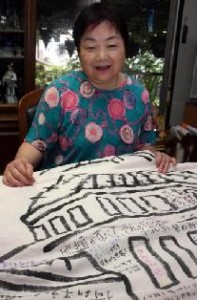Sharing the A-bomb Experience, Part 7
Aug. 4, 2009
Handing down her mother's experience
by Kyosuke Mizukawa, Staff Writer
As a child, Kimiko Takeuchi, 63, attended the Hiroshima Peace Memorial ceremony almost every year. Once she watched her mother weep at the Cenotaph for the A-bomb Victims. “My poor mother,” she thought at the time. She had never considered the fact that she, too, was a survivor of the atomic bomb (hibakusha).
Ms. Takeuchi, a resident of Saeki Ward, Hiroshima, was born on May 25, 1946, the year after the bombing. Her mother was exposed to the radiation emitted by the atomic bomb and cared for many hibakusha in their community. When Ms. Takeuchi was 35 years old, one of her friends told her, “If you were born by the end of May 1946, you’re a hibakusha.” She then realized that, having suffered prenatal exposure to the bomb’s radiation, she was a hibakusha, too.
In obtaining the Atomic Bomb Survivor’s Certificate, she felt the desire to learn more about her mother’s A-bomb experience. As it happened, one of her daughters was given homework for the summer vacation that involved interviewing family members about the circumstances of their exposure to the atomic bombing.
But, at first, her mother wouldn’t agree to an interview. “I’m sorry, I don’t want to remember it,” she said. “It’s so painful.” A few days later, though, she changed her mind, saying, “I can’t die without telling anyone about it.” Ms. Takeuchi, for the first time, sat down with two of her daughters to hear her mother’s story.
“If only I had told her to stay…” Her mother’s voice shook as she described the death of her sister, seven years older. On the eve of the atomic bombing, her sister, who was living in the city of Otake, came to stay the night at their house in Itsukaichi-cho. The next morning she joined the neighborhood association in helping to dismantle houses to create a fire lane near the hypocenter. She died in the blast, having suffered severe burns.
Ms. Takeuchi’s mother, who passed away in 1999 at the age of 83, did not talk about her experience again. But on August 6, five years before her death, she made the following entry in her diary: “Tears come to my eyes when I recall my sister’s kind face. If she was alive, she would be happy now, surrounded by grandchildren.”
In 2001, Ms. Takeuchi took part in a global voyage organized by Peace Boat, a Tokyo-based nongovernmental organization (NGO). The September 11 attacks occurred in the United States two days after the departure of the Peace Boat ship from Japan. The ship, in the Mediterranean Sea, came across a U.S. aircraft carrier heading to Afghanistan. Young people on the ship started making a banner to protest the U.S. action.
Watching from a distance, Ms. Takeuchi noticed the familiar image of the A-bomb Dome on the banner. “Why in the world don’t I, a Hiroshima native, raise my voice, too?” she thought, this feeling stirring within her for the first time. When the Peace Boat ship stopped in Barcelona, Spain, a port of call, she helped carry the banner to appeal for peace with about 100 others.
After the voyage, the banner was given to her “so it would be brought to Hiroshima, nowhere else.” But she wondered what more she could do without personal experience of the bombing. In 2008, the same NGO planned a global voyage that would carry about 100 hibakusha. This time she boarded with her mother’s diary and the banner. She was the youngest hibakusha among the group of survivors.
One of the hibakusha on board had produced an illustrated book to convey the day of the atomic bombing. Some talked about their hardships after the bombing and the discrimination they faced in getting married. The survivors shared their experiences with others in their own ways. Ms. Takeuchi displayed the banner on the ship and introduced her mother’s diary. She felt her confidence grow.
In April of this year, she accepted a request to speak, for the first time, at a peace education class at a local elementary school. “Even if we haven’t experienced the atomic bombing,” she told the children, “we can learn about it and share it with others in our own way.” These were words spoken to herself, too.
(Originally published on July 30, 2009)








